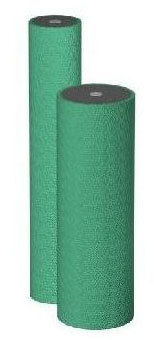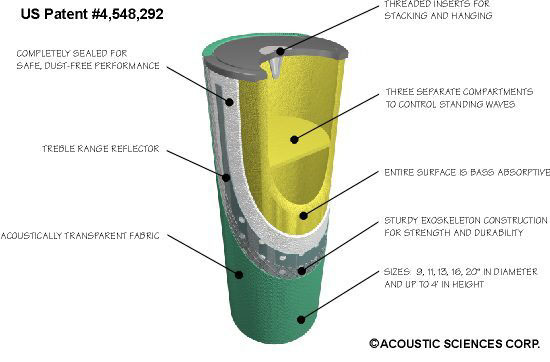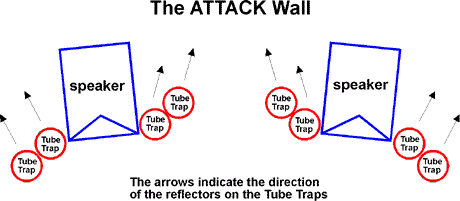![[SoundStage!]](../sslogo3.gif) Home Audio Home Audio Equipment Review |
|
September 1998Acoustic Sciences Corporation Tube Trapby Dave Duvall
Art Noxon founded Acoustic Sciences Corporation (ASC) in 1984. Since then, ASC has been firmly established as one of the leaders in the field of acoustic treatment. The subject of discussion here, the Tube Trap, was the world's first corner-loaded acoustic bass trap and can be found in home listening rooms, recording studios, concert halls, churches, and auditoriums throughout the world. Art's products are so significant that the FAA relies on them for acoustical control. Noxon has been licensed in the state of Oregon as an acoustical engineer since 1982, after earning an MS degree in mechanical engineering, with a focus on acoustics, and an MS in physics. He has presented several papers at the convention of the Audio Engineering Society, and owns patents to many acoustical products such as the Tube Trap, Studio Trap, and the Sound Flag. ASC's staff is chocked full of professionals in the areas of acoustics, recording, mechanical engineering, noise control, manufacturing, high-end audio, live sound, architecture, marketing, and graphic design. Along with a talented and knowledgeable president and staff comes the many awards that have been garnished upon ASC over the years. To name a few: several Golden Note Awards, The Academy for the Advancement of High End Audio Peripherals Design Award, and the 1996 Stereophile Product of the Year. Construction notes When I quizzed Christopher Klein, ASC’s sales manager, at HI-FI '98 about construction details for this review, he pointed me to the ASC website and told me that their advertising and website diagrams pretty much tell the world how to build a Tube Trap. While the basic design parameters may be shown, let me assure you that building a product as geometrically correct and cosmetically clean as those made at the manufacturing facility in Eugene, Oregon would be extremely difficult. And, of course, those patents should eliminate too much temptation of making your own Traps-for-profit. To save you from reading a thousand words, here's ASC’s diagram:
Review system From top to bottom: Muse Model Five transport linked via I2S connection to a Muse Model Two Plus DAC (with HDCD), Audible Illusions L-1 tubed (Seimens 7308) linestage, Belles 150A (100Wpc into 8 ohms) stereo amplifier, Cardas Golden Cross interconnects, Kimber BiFocal-XL speaker cables, Kimber AC PowerKords, PSB Stratus Gold speakers, TAD Systems (Bybee) Power Purifier, assorted cones, sand boxes, inner tubes, many hours of solitary confinement, and the occasional beer of choice. Where to begin? I spent several months with the Tube Traps before typing a single word. This is the kind of product that allows numerous possibilities for varying results, so I highly suggest you start out by letting Christopher Klein or Lee Schneider at ASC analyze your room. ASC offers a full design service, and through the review period I found them to be a very hands-on company. I faxed them a sketch that showed room dimensions, location and type of furnishings, soffits and ceiling pitches, description of wall and ceiling coverings, window locations, as well as some hidden "logon to SoundStage! now" subliminal messages that I think sneaked by without detection. What came back was a suggestion of eight 11"-diameter Tube Traps arranged in what is deemed as the "ATTACK Wall" configuration. Also supplied were two 16"-diameter Tube Traps, which Lee suggested I try in the corners. The ATTACK Wall is best described as two Tube Traps in the front periphery of each speaker and two more to each side, lined up on a diagonal with the front outside corner and the rear inside corner of the speaker (please see graphic below). The premise here is that the side traps horn-load the speakers to focus the bass toward the listener, causing the speakers to be more efficient. The front traps also aid in the same regard, as well as help tame the first reflection that would otherwise splay off the side wall, lessening focus and smearing individual events that would occur from the mixing of direct and reflected sound.
Absorption can also help a room that has a problem with slap echo settle down a bit. Too much absorption can be as detrimental as too little, choking the life right out of the music. I would suggest starting your trials with small amounts of absorption and diffusion, and build up until you've gotten the acoustic of the recorded music coming through, yet not doubled up by added room reverberation. To aid in getting the proper balance between absorption and diffusion, ASC designs their Tube Traps to have a reflective coating around half of the diameter, and this along with their round shape allows for diffusion in the all-important midrange. Don't like the way the room sounds one way? Spin some or all around and things brighten up a bit. Bass absorption isn't affected by this coating, and bass-boom reduction is possible with the Tube Trap spun any which way your heart desires. Cause and effect The ATTACK wall arrangement gave some very interesting results. For several weeks I was enamored with the precision that this configuration afforded. With the diffusor half facing the listener, focus was sharper than ever. Depth perception was increased, but I felt the width was slightly restricted. At the end of "Walking After Midnight" off the Cowboy Junkies’ Trinity Session CD [Classic Records RTHCD8568], the tape continues to roll as the band begins conversing and setting aside their instruments. There is a mandolin string plucked far right at one point, followed by a male voice asking "Chris, you remember the part where you went boing!?" big-time stage left. With the ATTACK Wall arrangement, these events appear just beyond the speaker edges. With the Traps or home-brew absorbers stationed at the first reflection point on the side walls, these events take place several feet away from the speaker edges, yet still located behind the speaker plane. The arrangement I preferred was of the more conventional "two Traps on each side wall, and trap the bejezzers out of the corners" method. The side-wall Tube Traps were positioned with a mirror, so one would catch the first reflection of the near speaker and the other catch the first reflection of the opposite speaker. No matter how the 11" Traps were positioned, the two 16" Traps were positioned in corners of the front wall, behind the speakers. My room has a couple of small jogs due to a platform and the bathroom-door wall at the rear corner, so I had plenty of corners left to stick the remaining traps in. This arrangement provided spaciousness without the loss of focus and imaging. There was a little better sense of the speakers disappearing, and this fed my senses and tastes to a fuller extent. No matter what setup I used, I always preferred the midrange diffusor toward the listening position as it added just the right touch of ambiance. My room is fairly large (28'Lx18'W, with a ceiling that slopes upward from 8' to 11'), but with carpeting and stuffed fabric furniture, it is not overly bright by nature, though it does need its reverberation time shaved down slightly. Postulating further... Toward the end of the review period, I started realizing that more Tube Traps could possibly be a good thing in my listening room. One thing I can say for sure, it takes more square footage of absorption and/or diffusion, strategically placed, than one might initially think. With my home-brew absorbers (main ingredient being R-38 unfaced insulation), it takes at least 60 square feet to create the live-end / dead-end configuration that I feel works well in my listening room. While the amount of Traps ASC sent was sufficient to create the ATTACK Wall setup they had designed for my room, in the more conventional setup I preferred, I would have liked to have had 8' Traps (which can be created by connecting two 4' traps together using the threaded insert holes), as well as a few more to create a wider first-reflection-point absorption area. Certainly more Traps could have been made available had I requested them, but to get a clear picture of how effective the Tube Traps were, I had enough to work with in either arrangement. Don't be shy in adding Tube Traps when you finally decide to take care of the room that could be holding your expensive stereo back from doing what it's truly capable of. If you have smooth surface walls and several doors and windows in your listening room, you can bet that without treatment of some nature you've got more acoustic reflection going on than your ear/brain combo can reasonably sort out. Remember our goal as audiophiles (and to a lesser degree with hobbyists and music lovers) is to reproduce as closely as possible what is recorded on the disc or album, and not to have it reinterpreted by such things as room acoustics. It is just this final level of audiophilia ad nausem that makes me wrestle with my conscience when I try to pin myself into one camp or the other. In my role as reviewer, though, critical listening is applied and my goal is that of the audiophile trying to ascertain what is accurate and what is not. Now, while I'll be the first to admit that without the absolute reference being used for comparison, that being the master tapes being played back via the original monitoring system (you thought I was going to say the actual live recording performance, didn't you?), subjectivity is the name of the game. Often what I might like to think is accurate reproduction may be no more than a sound that appeals to my personal tastes, and this is prima-facie evidence for letting your ears be the real judge and my words be mere guidelines and entertainment. Spotlight time While I was not able to tame some lower-midrange to lower-bass humps with the Tube Traps, I was able to do so with a little speaker and listening-seat positioning. I must have had some high hopes for the Traps in thinking that they'd take care of that, especially since I'd had no success in doing so with home-brew combinations. Once I got the logistics down better, Lee reminded me it was time to run through the MATT (Music Articulation Test Tone) track and really get to understand one of the major effects of Tube-Trapatitis. If needed, you could record the MATT results taken from a SPL meter's line output, being sure to turn off any automatic gain controls on your cassette recorder, and send the tape to ASC for analysis. The MATT test can be found on the Stereophile Test CD 2 [Stereophile STPH 004-2], and it is extremely handy for identifying parts of a limited frequency spectrum where your room or speaker positioning is interfering with the intelligibility of most of the deep bass through part of the upper midrange. The trick here is that the sweep tones that range from 28Hz to 780Hz and back down are separated by 1/16th of a second, and when all is well, they present themselves as distinct, individual tones of exactly 1/16th second duration. If you hear more of a garbled sound anywhere, the indication is that something is causing the tones in that portion of the frequency range to blend together. This can be caused by too long of a reverberation time, less-than-ideal speaker positioning, or audio reflections smearing the bursts together. With the Tube Traps in place, either in the ATTACK Wall mode or in first-reflection / corner-trapped position, the MATT test was reproduced with much more staccato and delicacy than without treatment. Certainly I won't go so far as to say that all inarticulations were magically removed, but it was clearly evident that working with the Tube Traps was a large step in improving the accuracy of the MATT signals. This reflects on the music as better resolution of low-level detail; the reduction of reflected signal must result in less masking due to signals that would otherwise tend to overhang and obscure such detail. Give it up for the Tube Trap folks! ASC Tube Traps work. I can't put it more simply than that. In my room they created much more articulate mid- to upper-bass performance, and aided in taming the acoustic reflections that would otherwise spoil the musical experience. If you've never experimented with absorption and diffusion in your room, may I highly suggest two things. First, grab a copy of F. Alton Everest's The Master Handbook of Acoustics, 3rd Edition, as it will help you understand the theories of acoustics as well as make sense of how to go about curing your acoustic woes. Second, when it comes time to take care of those problems, call ASC and let them take a hard look at your listening room. They will most certainly be able to suggest a combination of their products and a setup that will let your gear and recordings sound their best, without the room dragging them down. The Tube Traps were quite successful in putting it all together here, although if I'd had the scratch to purchase them I'd have bought a few more than were sent. The ASC products are derived from science, and perform admirably in the realm of subjective reviewing. If you need charts and graphs to satisfy your intellectual side, ASC has plenty of them to show you. For me, the proof was in the performance. What starts out prior to treatment as a ragged, bass-mushy, somewhat phasey sound overall turns into a well-defined soundstage with an eloquent bottom end once the full compliment of Tube Traps were applied. At some point in your audio game, you'll need to work on your room acoustics. When that time comes, save yourself a lot of experimenting and give the folks at Acoustic Sciences Corporation a chance to do their thing. Odds are you'll be pleased with their work and products, or as Lee summed it up, "We get VERY few returns!" ...Dave Duvall
|
|
|
|
![[SoundStage!]](../sslogo3.gif) All Contents All ContentsCopyright © 1998 SoundStage! All Rights Reserved |
 A little background for your edification
A little background for your edification
